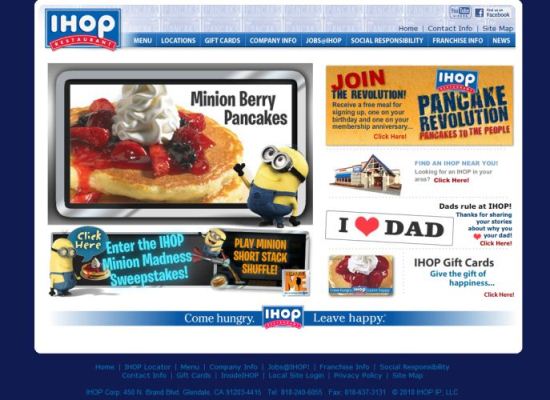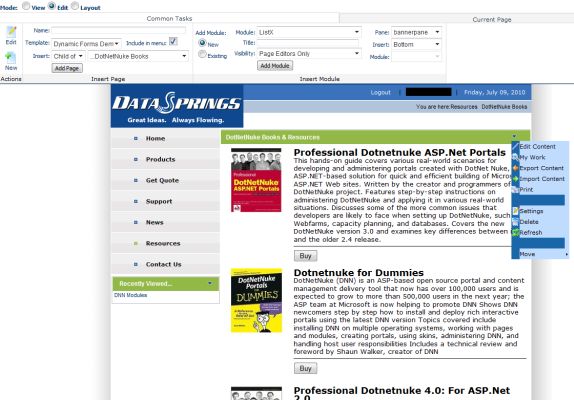DotNetNuke 5.4 and Joomla 1.5 Compared
Joomla and DotNetNuke are only two content management systems among many; however they are often regarded as best-of-breed for their respective technology stacks. DotNetNuke is an ASP.Net CMS written in Visual Basic, while Joomla makes use of the ever-popular PHP. Continuing in the path of our previous articles , we're going to examine the two frameworks to provide an impartial view of the advantages and disadvantages of both.
DotNetNuke was created by Shaun Walker in 2002. Based on the 'IBuySpy Portal' code Microsoft released to promote their ASP.Net framework, the application quickly acquired a large development community. Originally named the ‘IBuySpy Workshop’, the moniker was later changed to reflect the 'Nuke' suffix commonly affected by open source content management systems. The DotNetNuke Corporation was formed in 2006 to be a steering committee overseeing development of the framework which, as of July 2010, is in active use on over 600,000 websites.
Joomla was established in August 2005 as a fork of the Mambo CMS project. Senior developers, including Andrew Eddie, were unhappy with the direction Mambo was taking. So, in an open letter to the Mambo community, they announced their intention to form their own development team. The new project got its name from a community vote, Joomla being an anglicized form of an Arabic word meaning 'all together'. The first version of Joomla, released in September 2005, was essentially a re-branded release of Mambo 4.5.23; but since then the previous codebase has been expanded upon at an astounding pace, resulting in it becoming one of the leading PHP based content management systems. 2008 saw Joomla 1.5 released to much fanfare, as well as one of the lead developers winning a Packt award for most valued person. Today it continues to go from strength to strength, with prestigious firms like IHOP and CitiBank making use of Joomla both internally and on public facing sites.
 IHOP, a Joomla User IHOP, a Joomla User
Core Functionality: Both DNN and Joomla offer similar functionality at first glance, but it soon becomes apparent that DotNetNuke offers much more straight out of the box. Joomla supports basic functions like polls, blog layouts and a built-in search engine. It even has some more advanced options which are not available in other PHP based content management systems, for example load balancing and a trash bin to ensure articles are not deleted accidently. However, in comparison to DNN’s much wider range of built in functionality like database replication, events management and a photo gallery, the initial selection seems a little weak. The lack of a built-in forum system can particularly hurt Joomla based websites which wish to form communities, although there are plenty of forum bridges available as extensions.
Customization and Third Party Extensions: What Joomla lacks in core functionality, it tries its best to make up for with third party extensions. The sitemaps, wikis and multilingual content which DotNetNuke supports by default are freely available as open source plugins. A common saying in the Joomla world is that 80% of any site is an add-on, which arguably means the core framework is light-weight enough to support any type of site without necessarily coming with everything and the kitchen sink installed by default. Templates for Joomla are easy to create, and this is reflected by the vast number available across the Internet. The low barrier to entry can sometimes result in wading through a morass of poorly designed themes, but higher end commercial designs are often stunningly well put together.
Where Joomla does fall down is in the flexibility it provides. Although there are add-ons for most things working with the framework can often feel restrictive, especially when it comes to design. The templating system is fairly proscriptive, and so themes tend to be orientated around similar basic layouts. DotNetNuke allows for greater freedom of expression, giving the opportunity to create a more unique site style. DNN’s assumption that most customers will have some development knowledge may put many off, but also allows for more flexibility in the same manner that Microsoft’s SQL Server is more flexible than Access.
Underlying Technology: In any comparison between DotNetNuke and Joomla it is necessary to take into account the different technologies on which they are built. Joomla uses PHP with a MySQL backend, a combination that is prevalent in the web hosting sphere. By contrast DotNetNuke makes use of Microsoft’s ASP.Net framework which, while arguably superior on a technical level, is also more expensive to use in a shared web-hosting environment. That said many small and medium sized businesses already have servers which run Microsoft’s Internet Information Service (IIS), which nullifies the open source software stack’s price advantage.
Both Joomla and DotNetNuke can interact with LDAP based systems like Active Directory. However DNN has an advantage due to ASP.Net’s built-in membership and role providers, which allow businesses with their own development team to tie the system into their back-end more closely. Similarly the Visual Studio line of development environments makes code modification easier than most PHP based solutions. DotNetNuke is really designed for corporate intranets which need to integrate with existing systems, and is built around this kind of functionality. By contrast Joomla is more orientated towards providing a quick but expandable web presence.

ASP.Net Membership providers can allow close integration with your back-end systems
Support: The DotNetNuke framework offers several different levels of support. The basic ‘Community’ edition provides assistance primarily through developer forums, while the paid-for ‘Professional’ edition offers unlimited tier 2 online and email support. The ‘Elite’ version even incorporates live phone support with a 2 hour maximum response time. Joomla’s development team does not directly offer commercial support, but a number of third-party companies have built up considerable expertise with the system. These now offer training and support in much the same way as a Microsoft certified partner could support SharePoint.
The key issue which may sway business users in the direction of DNN is the fact that the professional and elite versions are officially tested and verified. This means they are guaranteed to be as stable as possible, making them a good choice for business critical applications. These versions also offer health monitoring and file integrity checking, which can ensure that potential issues can be detected and resolved early on.
E-Commerce: A qualitative evaluation of the key success attributes for online sales sites, made for the 11th International World Wide Web conference, highlighted what had been known for a long time; security and integrity are essential for any E-Commerce website. When comparing DotNetNuke and Joomla it can be seen that both frameworks support similar basic security features, like SSL encryption and email verification. However the professional edition of DNN also supports some extra features, such as granular privileges and sandboxing, which just give it the edge over Joomla in terms of functionality. When considering past performance it’s best to turn to Secunia, an independent security consultancy which maintains a list of vulnerability assessments for close to 30,000 different pieces of software.
As of July 2010 Secunia’s website shows 28 vulnerability advisories for Joomla, of which none are unpatched. DotNetNuke has only 7 total advisories , and similarly none unpatched. In both cases it seems that the teams are able to resolve their security issues, but the increased number of advisories for Joomla might make some business users wary of another potential zero-day exploit.
When considering actual E-Commerce functionality, all editions of DNN come with affiliate tracking and a shopping cart included as standard. By comparison Joomla supports most e-commerce functions through third-party extensions, and hence isn’t ready for Internet marketing out of the box.
Integrating some of the available shopping carts into Joomla can be difficult, and may result in them looking tacked onto the design. This likely isn’t an issue for smaller businesses just starting to dip a toe into online sales, but may become a limiting factor when looking to upgrade a few years down the line.
Ease of Use: The inline administration model of DotNetNuke allows for quick and easy editing of content, whereas Joomla requires you to sign into a separate area of the site before making changes. DNN’s use of the drag and drop paradigm when modifying the position of modules is especially useful compared to Joomla’s more clunky back-end system. Beyond that the two frameworks share similar ease of use features with mass uploading, built in macro languages and search engine friendly URLs available by default.

Inline Administration in DotNetNuke
In a comparison between Joomla and DotNetNuke, several things become evident. DNN arguably has an advantage in core functionality, however is lacking some of the third party extensions which make Joomla so appealing. Joomla’s style of administration is not as elegant as DotNetNuke’s in-line editing, and generally the framework is not as flexible. However it can be very quick to get a site based on a generic layout up and running. As such Joomla is likely ideal for making quick, inexpensive and moderately interactive websites.
DotNetNuke is aimed more at the creation of business scale web sites and web applications. Tight integration with existing systems and a usable e-commerce solution out of the box make it a winning formula for companies who want to set up an initial online sales presence. At the same time the stable, professionally certified and supported version is ideal for use in business critical applications, as well as high traffic community hubs.
Link to previous comparison article / the category title if you like
http://www.dotnetnuke.com/
http://www.joomla.org
http://www.opensourcematters.org/index.php?option=com_content&task=view&id=1&Itemid=1
http://www2002.org/CDROM/poster/155.pdf
http://secunia.com/advisories/product/5788/
http://secunia.com/advisories/product/26780/
|
|